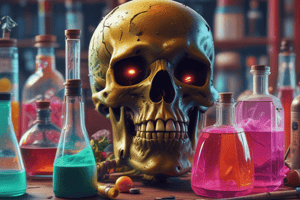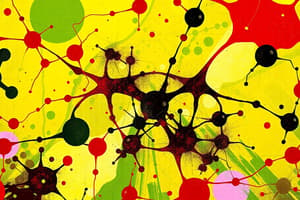Podcast
Questions and Answers
Which branch of toxicology is most directly concerned with identifying chemicals in the workplace that may pose a risk to worker health?
Which branch of toxicology is most directly concerned with identifying chemicals in the workplace that may pose a risk to worker health?
- Ecotoxicology
- Environmental Toxicology
- Forensic Toxicology
- Occupational Toxicology (correct)
A patient arrives at the emergency room experiencing muscle weakness and pinpoint pupils after being exposed to an unknown substance. Which of the following conditions should the medical team suspect as a possible cause?
A patient arrives at the emergency room experiencing muscle weakness and pinpoint pupils after being exposed to an unknown substance. Which of the following conditions should the medical team suspect as a possible cause?
- Narcotic Overdose
- Acid Ingestion
- Cholinergic Toxicity (correct)
- Heavy Metal Poisoning
Which of the following best describes the contribution of Mathieu Orfila to the field of toxicology?
Which of the following best describes the contribution of Mathieu Orfila to the field of toxicology?
- Discovering the concept of dose-response relationships.
- Formally classifying poisons based on their effects and detection. (correct)
- Identifying antidotes for common poisons.
- Pioneering the use of statistics in toxicology.
A researcher is evaluating the safety of a new pesticide. Which type of toxicology is responsible for conducting toxicity testing to determine potential hazards and establish safe exposure levels?
A researcher is evaluating the safety of a new pesticide. Which type of toxicology is responsible for conducting toxicity testing to determine potential hazards and establish safe exposure levels?
A forensic toxicologist is tasked with determining the cause of death in a suspicious case. Which approach would they most likely employ?
A forensic toxicologist is tasked with determining the cause of death in a suspicious case. Which approach would they most likely employ?
Which term describes a situation where exposure to one chemical, which is non-toxic itself, increases the toxicity of another chemical when they are both present?
Which term describes a situation where exposure to one chemical, which is non-toxic itself, increases the toxicity of another chemical when they are both present?
A patient experiencing anaphylactic shock due to a bee sting receives an injection of epinephrine. What type of antagonism is exemplified by this treatment?
A patient experiencing anaphylactic shock due to a bee sting receives an injection of epinephrine. What type of antagonism is exemplified by this treatment?
A patient has ingested a toxic dose of paracetamol. Which of the following initial steps is MOST appropriate according to the principles of clinical toxicology?
A patient has ingested a toxic dose of paracetamol. Which of the following initial steps is MOST appropriate according to the principles of clinical toxicology?
In cases of poisoning, why is the gastrointestinal route of administration generally considered less toxic than the intravenous route?
In cases of poisoning, why is the gastrointestinal route of administration generally considered less toxic than the intravenous route?
A child ingests an unknown quantity of iron tablets. Which of the following chelating agents is most appropriate?
A child ingests an unknown quantity of iron tablets. Which of the following chelating agents is most appropriate?
If a patient has been poisoned with a substance that is primarily eliminated through the kidneys, but also has a small volume of distribution and is not strongly bound to plasma proteins, which extracorporeal method would be most effective?
If a patient has been poisoned with a substance that is primarily eliminated through the kidneys, but also has a small volume of distribution and is not strongly bound to plasma proteins, which extracorporeal method would be most effective?
To treat poisoning from cyanide, amyl nitrite is administered, which induces the formation of methemoglobin. Why is methemoglobin formation a necessary part of the cyanide poisoning treatment?
To treat poisoning from cyanide, amyl nitrite is administered, which induces the formation of methemoglobin. Why is methemoglobin formation a necessary part of the cyanide poisoning treatment?
Which of the following best describes the mechanism of action of activated charcoal in treating ingested poisons?
Which of the following best describes the mechanism of action of activated charcoal in treating ingested poisons?
After an industrial accident, a worker inhales a high concentration of carbon monoxide. What is the primary mechanism by which carbon monoxide exerts its toxic effects on the body?
After an industrial accident, a worker inhales a high concentration of carbon monoxide. What is the primary mechanism by which carbon monoxide exerts its toxic effects on the body?
Which of the following is the MOST appropriate treatment for a patient who has ingested ethylene glycol (antifreeze)?
Which of the following is the MOST appropriate treatment for a patient who has ingested ethylene glycol (antifreeze)?
Flashcards
Poison
Poison
Any chemical agent causing body injury, disease, or death.
Clinical Toxicology
Clinical Toxicology
Study of symptoms, mechanisms, treatments, and detection of poisoning, especially in people.
Forensic Toxicology
Forensic Toxicology
Combination of analytic chemistry and toxicological principles to establish cause of death.
Lethal Dose 50 (LD50)
Lethal Dose 50 (LD50)
Signup and view all the flashcards
Hazard
Hazard
Signup and view all the flashcards
Risk
Risk
Signup and view all the flashcards
Types of Antagonism
Types of Antagonism
Signup and view all the flashcards
Synergistic Effect
Synergistic Effect
Signup and view all the flashcards
Poisoning Effects
Poisoning Effects
Signup and view all the flashcards
Remote Effects
Remote Effects
Signup and view all the flashcards
Routes of Administration
Routes of Administration
Signup and view all the flashcards
Acute Poisoning
Acute Poisoning
Signup and view all the flashcards
Idiosyncrasy
Idiosyncrasy
Signup and view all the flashcards
Irritants
Irritants
Signup and view all the flashcards
Gastric Lavage
Gastric Lavage
Signup and view all the flashcards
Study Notes
- Toxicology is the study of poisons, where "toxi" refers to poisons and "logos" means study.
- A poison is any chemical agent causing serious body injury, disease, or death when applied, introduced, or developed inside the body.
- Toxicology is a branch of pharmacology dealing with the undesirable effects of chemicals on living systems, from individual cells to complex ecosystems.
- It encompasses the adverse effects of chemical, physical, or biological agents on people, animals, and the environment.
- Toxidrome refers to a toxic syndrome, which is a constellation of clinical signs and symptoms suggesting a type of poisoning, e.g., Cholinergic Toxicity = dumbbells.
- "Sola dosis facit venenum" is a quote by Paracelsus meaning "the dose makes the poison".
- Paracelsus is known as the father of toxicology.
- Mathieu Orfila is considered the modern father of toxicology, having written "Toxicologie Générale".
- Toxicologie Generale is a book that briefly describes the symptoms of poison, antidote, detection/identification tests, and dose.
- Orfila classified poisons into irritants, narcotics, narcotic-acrids, and septics or putrefactives.
Branches of Toxicology
- Environmental toxicology deals with the impact of chemicals (as pollutants) on living organisms.
- Ecotoxicology focuses on the toxic effects of agents on populations and communities within ecosystems.
- Occupational toxicology concerns chemicals in the workplace, their diseases, safe usage conditions, and prevention of harmful absorption.
- Monday headache is a classic example caused by Organic Nitrates (NTG) exposure = workers develop tolerance, Organic Nitrates dilates BV (vasodilator) = monday headache & migraine.
- Mechanistic toxicology researches the toxic action mechanisms (toxicodynamics) of poisons Toxicodynamics: Mechanism of Toxicity (MOT).
- Descriptive toxicology involves toxicity testing for safety evaluation and regulatory requirements and Provides information regarding toxic levels.
- Regulatory toxicology gathers/evaluates toxicological data to establish concentration-based "safe" exposure standards and Makes policies.
- Forensic toxicology involves medico-legal aspects of chemical effects on humans/animals, using analytic chemistry & toxicology principles.
- Experimental toxicology investigates toxic effects of chemicals in biological systems, measuring parameters.
- Lethal Dose 50 (LD50) is the dose causing death in 50% of test animals.
- Toxic Dose 50 (TD50) causes toxic effect to humans.
- Threshold Limit Value (TLV) is the safe exposure amount for a time period = more on exposure.
- No Observed Adverse Effect Level (NOAEL) is the amount/highest dose without adverse effects.
- Clinical toxicology focuses on substance effects in patients from accidental poisoning/intentional overdoses Patient care/patient-centered.
Definition of Terms
- Hazard is the likelihood of injury in a situation, reflecting the capacity/probability to cause harm, injury, and death.
- Risk is the expected frequency of an undesirable effect from exposure to a chemical/physical agent.
- Intoxication is toxicity related to any chemical substance.
- Poisoning is a clinical toxicity secondary to accidental exposure.
- Overdose is an intentional exposure causing self-injury/death.
Evidence of Poisoning
- Corpus delicti means there should be evidence before someone is convicted of a crime.
- Circumstantial evidence (moral/indirect evidence) involves deductions from circumstances but it is Not reliable.
- Symptomatic evidence includes symptoms observed, but is not conclusive due to similar symptoms from other diseases.
- Chemical evidence involves analysis of suspected substances or body secretions and Can be obtained while px is still alive.
- Post-mortem evidence is observed through autopsy.
- Experimental evidence is determined through physiologic tests on living animals & may not be conclusive to man since tolerance may not be the same as in man.
Interactions of Poisons
- Additive effect (1+1=2) is the combined effect equals sum of individual effects.
- Synergistic effect (1+1=3) is the combined effect exceeds sum of individual effects.
- Carbon tetrachloride + Ethyl alcohol = CNS depression; Pyrethroids + Piperonyl butoxide (PBO) = good for insects.
- Potentiation (1+0=2) is where exposure to a non-toxic chemical increases the toxicity of another, e.g., Carbon tetrachloride + Isopropyl alcohol = ↑CNS dep fx, ↑Toxicity.
- Antagonism (1+1=0) is co-administration interferes with toxicity of both/one agent, used for antidotes.
- Functional/Physiological Antagonism involves opposite effects on a physiological function, binding to different receptor but opposite fx.
- Anaphylactic shock (↑ histamine) treated with epinephrine, Epinephrine vs Histamine.
- Chemical/Inactivation involves chemical reaction between compounds, reducing toxic compound w/No receptor involved, e.g., Chelators and metals.
- Heparin vs Protamine Sulfate, Warfarin vs Vit. K.
- Dispositional involves changing toxic chemical disposition diminishing concentration/duration.
- E.g. Ipecac, charcoal, pH alteration, metabolism induction or inhibition, still no receptor involved, they just antagonize the ADME process.
- Receptor is also known as Pharmacological antagonism & involves one agonist and one antagonist binding to the same receptor.
- Chemicals compete for the same receptor, decreasing effective binding of toxic compound.
- Naloxone (opioid antagonist) and morphine (opioid agonist) are examples and Naloxone is FDA approved to reverse opioid receptor effects.
Poisoning Effects
- Local effects are impressions made by the poison at the contact site, e.g., corrosives.
- Remote effects occur in areas other than the application site, e.g., Atropine taken orally to produce blurred vision.
- Combination of local and remote effects, e.g., Phosphorus, Cantharidin, Arsenic.
Factors Affecting Poisoning Effects:
- Injected poisons are more toxic compared to those that are swallowed
- Increased dose increases toxicity probability.
- Highly lipid-soluble poisons are absorbed dermally; water-soluble poisons are absorbed faster orally.
Types of Poisoning
- Acute is prompt with marked functional disturbances/death.
- Excessive single dose example = taking 8 tablets of paracetamol then after 15 mins another 8 tablets
- Chronic has gradual/progressive deterioration from small doses over extended time; may/may not result in death.
- Cumulative action increases intensity when reaching a limit.
- Paracetamol (>4g-8 tablets) = toxic dose, Aluminum (too much exposure is toxic).
Duration and Frequency Factors
- Acute: less than 24 hours, generally single dose.
- Subacute: repeated exposure in <1 month.
- Subchronic: repeated exposure for 1-3 months.
- Chronic: repeated exposure for >3 months.
- Acute and chronic exposures lead to outcomes.
- Benzene (CH) produces acute CNS narcosis or chronic bone marrow damage.
Types of Poisoning Based on the Effects
- Irritants cause tissue necrosis on contact (caustic effects) = acid & alkali.
- Neurotics affect the CNS e.g., hallucinogens; causes hallucination, depression, mania, delusion.
- Asphyxiants cause dyspnea (SOB, breathing problem) e.g., methane gas, carbon monoxide.
- Lacrimators stimulate flow of tears (irritates eyes) e.g., organophosphates, onion.
- Sternutators cause excessive sneezing (eg: Red and Black Pepper).
- Globally Harmonized System (GHS) are international symbols.
General Management of Poisoned Patients
- Acute poisoning is intentional, especially in adult px, while childhood death/poisoning is attributed to negligence of the adult accompanying the child
- How do you know How Does the Poisoned Patient Die?
- CNS depression can cause coma from airway obstruction
- Severe hypotension from Shock, possible Lethal Arrhythmia, and even CV toxicity, inflamed heart (because of arrhythmia).
- Date rape drug, Flunitrazepam (Rohypnol®) = arrhythmia: tachycardia.
- Cellular hypoxia (low oxygen).
- Seizure, muscle hyperactivity, possible rigidity.
- Severe organ damage for either acute (immediate) or a long-delayed concept.
Types of Poisoning: Based on the Effects
- Always evaluate and support vital functions
Evaluating Airway
- Obstructed airway
- Flaccid Tongue: foaming of the mouth. Use position in lateral decubitus.
- Pulmonary aspiration of gastric contents (hospital). Stomach contents will migrate to the lungs.
- Respiratory failure (hospital)
Causes of Breathing failure
- Check with an Oximeter
- Carbon Monoxide Poisoning is a good example.
- Prevent leaving children alone in a car seat, as poisoning may result from the Carabon Dioxide Poisoning
- Carbon Dioxide is an example of asphyxiants which means is associated with (SOB)
- Complications with breathing failure include Hypoxia, possible Ventilatory Failure, and Bronchospasm
Evaluating Circulation
- Check their BP, HR and Urinary Output (catheter)
Decontamination
- Look for diagnosis
Test to detect specific poisons
- Use the Beilstein test to detect Chlorine. This test will create a .green flame
- Use the Beilstein Benzoldt to detect Acetone . This test creates an indigotine color.
- Use the Gunning test to detect Bromine This test creates a colored precipitate.
- Use the Water Brown Ring test to detect Nitrite & nitrate. This test creates a brown ring at the interface.
- Use the Lieben's lodoform test to detect detect Methanol. This test creates yellow (iodoform (CHI3)).
- Use the Marsh test to detect Arsenic. This test is soluble in NaOCI
- Rodillon/ Phenol. This test can give light to dark red colors
Test to detect specific poisons
- An overviw of the drugs and the metabolic that may me detected
Clinical Toxology: P2 ~ Steps for Decontamination
Routes Exposure
Removing of toxins by.
- Inhalations. Provide 100% Pure Oxygen, ventilation and bronchodilators
- Dermal: remove contamination with slightly cool water
- if exposed to acids and bases -wash the wound with cold and or running water with soap
- Occular Exposure: irrigate area with irrigation w 15 minutes -* Do not instill any neutralizing solutions in areas such as the skin and eyes, etc
Common routes of exposure:
- oral exposure
- Oral and Parental Adminstration
Steps for removing Toxins ~
-
Perform a Gastric Lavage:
- safe and used properly with extreme care
- perform properly in an ER
- Also can be called stomach pumping or irrigation
- Uses Orogastric(mouth0 of nasogastric tubes (to the nose).
-
Uses: -* In patients who are not mentally alert -* In patients with decreased gag reflex function -* if ingestion is massive take action and check as early as 1 minutes
- contraindications -ingestions of hydrocarbons -at risk for Gi perforation -combative or convulsive patient
-
Induce Emmesis
- most convenient with hospital treament
- perform and use proper Syrup of Ipecac
-
contraindications: -*<6 months -seizures - Patients with acid of sharp objectives ingestions
-
Precipitations -* Alter poison by chemical reaction
-
Adsorbents --Form Physical components
Chemcial antidotes
- Metal Poisons use Dimercaprol of BAL
- Alkoids can use diazapam
- Strychnine can use anticonvulsion meds
10
Studying That Suits You
Use AI to generate personalized quizzes and flashcards to suit your learning preferences.




